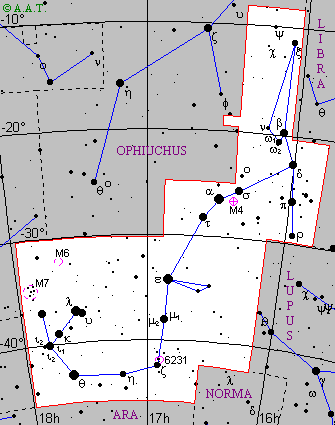 |
 |
| English name | Scorpion | ||||
|---|---|---|---|---|---|
| Major stars | alpha Scorpii | Antares | magn. 1,0 | RA: 16h 29m 24.45s | Dec: -26° 25' 55.1" |
| beta Scorpii | Graffias | magn. 2,8 | RA: 16h 05m 26.24s | Dec: -19° 48' 19.3" | |
| delta Scorpii | Dschubba | magn. 2,5 | RA: 16h 00m 20.02s | Dec: -22° 37' 17.9" | |
| epsilon Scorpii | magn. 2,4 | RA: 16h 50m 09.93s | Dec: -34° 17' 35.3" | ||
| eta Scorpii | magn. 3,4 | RA: 17h 12m 09.21s | Dec: -43° 14' 20.2" | ||
| theta Scorpii | magn. 2,0 | RA: 17h 37m 19.15s | Dec: -42° 59' 52.0" | ||
| iota1 Scorpii | magn. 3,1 | RA: 17h 47m 35.09s | Dec: -40° 07' 37.1" | ||
| kappa Scorpii | magn. 2,5 | RA: 17h 42m 29.26s | Dec: -39° 01' 48.2" | ||
| lambda Scorpii | Shaula | magn. 1,7 | RA: 17h 33m 36.55s | Dec: -37° 06' 13.5" | |
| my1 Scorpii | magn. 3,1 | RA: 16h 51m 52.23s | Dec: -38° 02' 51.0" | ||
| pi Scorpii | magn. 3,0 | RA: 15h 58m 51.13s | Dec: -26° 06' 50.6" | ||
| sigma Scorpii | magn. 3,1 | RA: 16h 21m 11.32s | Dec: -25° 35' 34.1" | ||
| tau Scorpii | magn. 2,9 | RA: 16h 35m 52.95s | Dec: -28° 12' 57.7" | ||
| ypsilon Scorpii | Lesath | magn. 2,8 | RA: 17h 30m 45.84s | Dec: -37° 17' 45.0" | |
| SAO 209318 | magn. 3,3 | RA: 17h 49m 51.53s | Dec: -37° 02' 35.7" | ||
| Description | Constellation of the zodiac, through which the Sun transits during the last days of November. It is to the south of Ophiuchus. Scorpius contains many bright stars, that make it a very evident constellation: the principal star is Antares (from Greek, "anti Mars, rival of Mars", because of its red color which makes it to resemble this planet). It is a very enormous red supergiant: it seems that its diameter is at least three hundred times greater than that of our Sun. Beside being a variable of long period, it is also a double, considering that it has a blue companion of sixth magnitude, rather difficult to be seen. The constellation contains a lot of other double stars. Zeta and my Scorpii are two couples of white-blue stars, easily separable to the naked eye; and to the naked eye is also seen omega Scorpii, formed by a white star and by a yellow giant. You need small telescopes instead to observe beta, ny and xi Scorpii: this last is a multiple star constituted by well four stars which are gravitationally connected. In the southern zone of the constellation there are some interesting open clusters. M6, formed by about fifty stars among which dominates a red giant of sixth magnitude: it is also called Butterfly Cluster because of its characteristic shape. M7, a wide and bright cluster visible to the naked eye. And finally NGC 6231, composed by about 120 stars, a lot of which are of sixth magnitude: it is excellent to be observed with binoculars.
|
||||
| Mythology and history | The constellation represents the scorpion which Artemis sent to sting Orion to punish him for his haughtiness. For the Greeks this constellation was also extended in the zone today occupied by Libra, that represented the scorpion's nippers: in the first century before Christ, the Romans drew the new constellation and so reduced Scorpius' dimensions. |
||||
 Back to constellations page.
Back to constellations page.